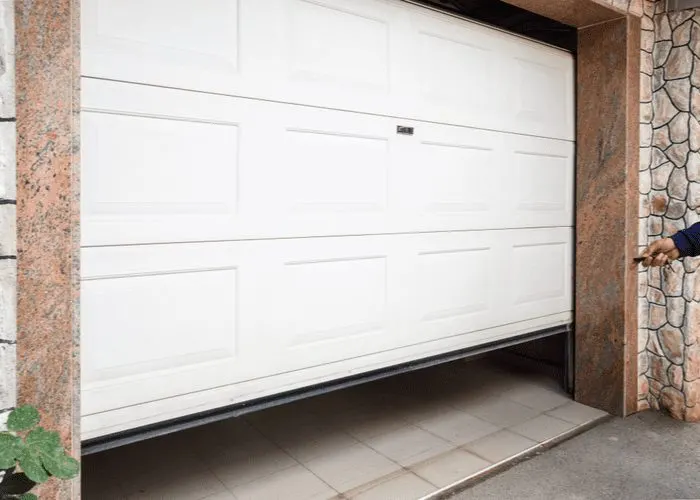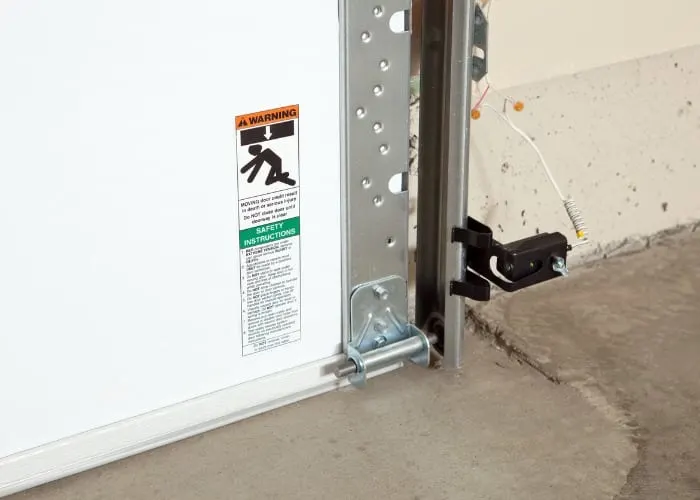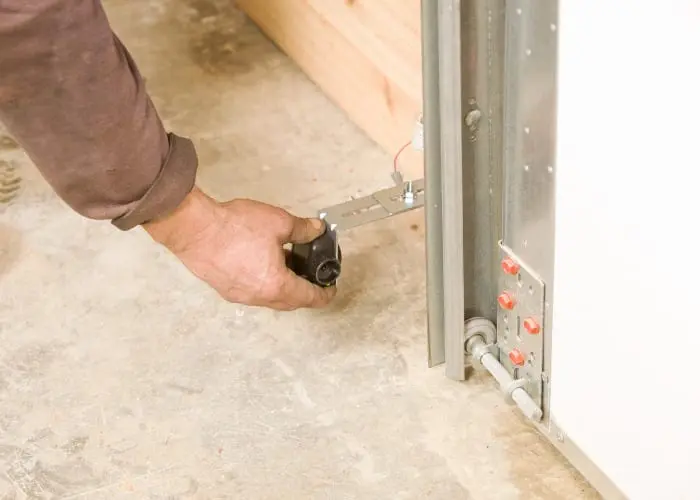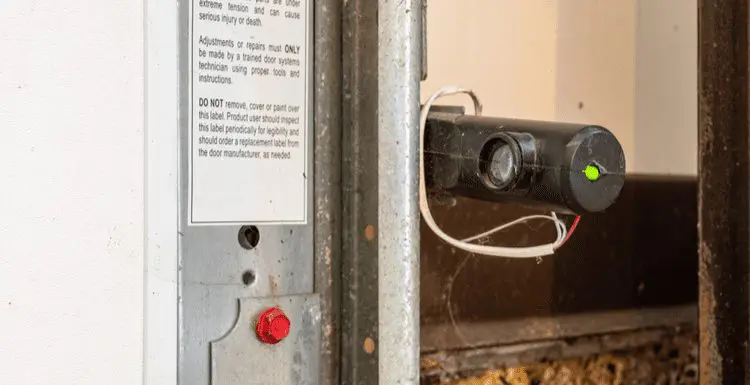If you’ve been wondering how to align garage door sensors, this guide is for you.
These little buggers are very important. Here’s how to make sure yours are aligned and in perfect working order.
Important Note: Keep in mind that the steps listed below are general. You should check your garage door owner’s manual or contact the manufacturer to get specific instructions for your door’s brand and model.
Wondering How to Align Garage Door Sensors?

GagoDesign/Shutterstock
Garage door sensors prevent your heavy garage door from posing a serious danger to people, pets, and vehicles who may be under it when it shuts.
These safety sensors are a must to keep your family and property protected. They’re also required by law. And for good reason.
The problem is that they only work if they’re in perfect alignment.
Improperly aligned garage door sensors create a lot of unnecessary risks. They can also prevent your garage door from shutting at all.
Instead of lowering completely to close, they may repeatedly reverse and open.
Fortunately, fixing this issue isn’t hard. You just need to know which steps to take! We’ve got you covered with all the information you need to get this quick job done.
We’ll cover the following topics in this guide:
- What are garage door sensors and how do they work?
- Signs your sensors are out of alignment
- How to align your garage door sensors
- Frequently asked questions
We’ll start with the basics and how garage door sensors work first. Then, we’ll look at some of the signs that your sensors may be out of alignment.
You’ll see step-by-step instructions on aligning garage door sensors next, followed by a list of the most frequently asked questions we see on this topic. Let’s get started.
What Are Garage Door Sensors?

BanksPhotos/iStock
Garage door sensors detect objects in the garage door’s path and reverse the direction of the door to avoid hitting any object. They may be called by many names: safety reverse sensors, photo-eye sensors, or safety eyes.
If anything is under or very near the garage door when it is closing, these safety sensors instantly detect it and start raising the door instead of continuing to close it.
This prevents any person or object from being hit by or trapped under the door. Their primary purpose is safety. Maybe a child or pet wanders into or out of the garage while the door is closing.
Perhaps you’re still backing out when the door starts to come down. It could be a fallen box or item that suddenly lands near or under the garage door’s path.
You might have someone accidentally push the door’s close button while you’re standing under the door. There are many scenarios where a garage door can cause harm or damage without these important sensors.
How Garage Door Sensors Work
Now that you know what these sensors do, it’s a good idea to learn how they work. This will help explain the alignment issue you may be having as well.
Garage door sensors work by emitting a beam of light from one sensor (the sender) to another installed on the opposite side of the garage door (the receiver). These two sensors constantly “communicate” with this beam of light.
As long as the receiver can sense or detect the beam of light being sent from its counterpart, the garage door will be allowed to open and close as normal.
But the second that beam of light is interrupted or blocked, even by something small, the sensors will start reversing the direction of the door from downward to upward.
The watchful “eye” of the receiving sensor is always on and always working, as long as the two sensors are properly aligned.
Signs Your Garage Door Sensors Are Out of Alignment
So how can you tell if your garage door safety sensors are out of alignment?
Thankfully, there are a few telltale signs that indicate when these sensors aren’t properly aligned. Here’s what you should be looking for.
1. Blinking LED Lights on Door Sensors
The sensors use invisible light to communicate with each other, but they use LED lights to indicate they’re working.
If you notice that the LED light indicator on one or both of your sensors is flickering or blinking, it’s a sign they may be out of alignment.
Both LED indicator lights should be on with a steady glow. They won’t blink unless:
- There’s a problem with alignment
- Something is blocking the beam of light used to detect objects near the door
If you take a look and nothing appears to be near the door to block the beam, it may be a misalignment causing the lights to blink.
2. Garage Door Won’t Close
If your garage door won’t close or repeatedly opens when you try to shut it, it could be a sign that your sensors are not properly aligned.
Misaligned garage safety sensors cannot properly communicate. In perfect alignment, one shoots out the beam of light in a straight line, and the other receives or detects it on the opposite side of the door.
If one of the sensors is even slightly misaligned (placed too high or too low), the beam of light used as a signal won’t reach the receiving sensor.
When this happens, it can cause the sensors to falsely believe something is in the way of the door. This will prevent the door from closing at all or continually force the door to start opening each time you try to close it.
3. Garage Door Signal Light Blinks and Flashes
Another sign that your garage door sensors are out of alignment is a lot of blinking, flashing, and clicking when you try to shut the door.
If you hit the close button and the signal light inside your garage flashes and blinks ten times, the problem very well may be a misalignment of the sensors.
You may also hear clicking when this happens. First, check to ensure there’s nothing actually in the way of the door.
If nothing appears to be near the sensors, the next step is to check the alignment of the sensors. We’ll show you how to check the sensors and align them properly next.
How to Align Garage Door Sensors

BanksPhotos/iStock
If you’ve experienced any of the signs listed above, you’ll need to learn how to align garage door sensors to fix the problem. Aligning these sensors is an easy job. But you need to follow each step carefully to avoid creating more issues with your garage door.
In most cases, the garage safety sensors should be installed no higher than 6 inches off the floor. They should face each other.
But it usually doesn’t matter which sensor you place on either side of the door. Make sure to install the receiving sensor on the side where it won’t be subjected to direct sunlight.
1. Close the Garage Door
Closing the door first ensures you won’t be causing it to open and close while you work on the sensors.
If you’re having trouble closing the door because it keeps reversing and opening, try holding the close button down until it makes contact with the floor.
2. Find and Inspect the Sensors
Find the safety sensors on either side of the garage door, located no more than 6 inches off the ground. You should see glowing LED lights on each one.
They may be blinking or flickering if there is indeed a problem with the alignment. Check each sensor for dirt and debris. Dust, grime, cobwebs, and even unnoticed bird nests are common reasons for door sensors failing to communicate with each other.
If you see visible dirt or debris on the sensors, flip the garage door breaker switch to the off position on your electrical panel. Then, use a damp, soft cloth to remove it.
Be careful not to scratch or harm the lens of the receiver sensor. Then, flip the breaker switch back on and see if cleaning the sensors fixed the problem. If not, continue to the next step.
3. Align the Sensors
Safety Note: Before beginning this step, cut the power to your garage door at the circuit breaker. Find the switch that is connected to the garage door and flip it into the off position. This ensures your safety while you work on the sensors.
You’ll need the following tools to align garage door sensors:
- Screwdriver
- String
- Tape measure
- Level
First, use your screwdriver to loosen (not remove) the screws securing each of the sensors. You should be able to slide the bracket they’re mounted to up and down once you get the screws loosened.
Use your tape measure to slide one sensor down until it is no more than 6 inches off the floor. You can slide it lower if you’d prefer, but 6 inches should be the maximum height.
Tie your string to the sensor you’ve moved. Make sure it’s long enough to reach across the garage door to the other sensor. Now, run it across and tie it to the sensor on the opposite side.
Make sure the string is tied to the center of the sensor. This ensures the infrared light beam will be able to reach the eye of the receiving sensor when you’re done. Start by lowering the second sensor until it looks reasonably level with the first.
Watch the string to get an idea of how far down to move it. Once you think it’s almost level, use your level on the string to make sure the alignment is perfect.
You can adjust the sensors as needed to get them both level. Once the sensors are level and aligned in place, use your screwdriver to tighten the screws securely on each one.
Pull out the level once more to double-check and ensure the sensors are still in the level position. Flip the circuit breaker switch back on and test the garage door to see if this fixes the problem. You’ve successfully aligned your garage door sensors!
Video Explainer
Frequently Asked Questions
Here are some frequently asked questions about garage door sensors and their alignment:
Where can I find my garage door sensors?
Your garage door safety sensors will be located on either side of the garage door. They will be installed inside your garage no more than 6 inches off the ground.
Why is one sensor’s LED light green and the other orange?
You will notice that each sensor has a different colored LED indicator light. The green light is on the receiving sensor that detects infrared light. The orange or red light is on the sending sensor that emits the infrared light.
Why do I have to hold my garage door button down to close it?
If you have to hold the button down until the door closes because it keeps trying to open or won’t budge unless you hold it down, you’re bypassing the safety system. This is similar to doing a hard shutdown on a computer or smartphone.
If this is the only way you can close your garage door, the safety sensors are likely misaligned. Follow the instructions above to align them.
Why is the signal light in my garage blinking when I try to close the door?
Flashing or blinking garage signal lights may indicate that there is an object close to the door and blocking the sensors. Check for anything that may be in the way of the door and move it away.
It may also indicate that the sensors are misaligned and need to be moved. See instructions above to realign your sensors.
I realigned my sensors, but there’s still a problem. What should I do next?
If you’ve followed the instructions to clean and align your garage door safety sensors and the problem still exists, you’ll need to contact a professional.
They will be able to inspect your garage door sensors, wiring, and setup to fix the issue.
How can I test my garage door sensors to see if they work properly?
It’s a good idea to test your garage door safety sensors regularly to ensure they’re working. To test them, just open the garage door and then place an object in the path between the two sensors (like a box, bike, laundry basket, etc.).
Use the remote to try and close the garage door with the object in the way. If the door stops closing, reverses, and begins opening again, you’ll know the sensors are working properly.
So, How Do You Align Garage Door Sensors?
If you’ve read the guide and watched the video above, congratulations! You now know how to align garage door sensors.
We hope that you’ve learned something. And while you’re here, check out our many other guides on home improvement and maintenance topics.

